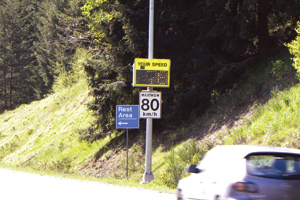Senior Reporter
Ontario Court Upholds Speed-Limiter Mandate

The Ontario Court of Appeals has rejected a challenge to the Canadian province’s rule requiring speed limiters on trucks, while U.S. regulators said their speed-limiter proposal will be stalled beyond its projected Sept. 21 release.
The Canadian appeals court ruling was on a 2009 legal challenge by a now-deceased trucker who was cited during an inspection for having his speed limiter set at just over 68 mph, a violation of Ontario’s requirement that truck limiters be set at 105 kilometers, or about 65 miles per hour.
Court documents said the intended benefits of Ontario’s limiter rule include lowering greenhouse-gas emissions, reducing the severity of collisions and preventing crashes.
But the driver, Gene Michaud, alleged that limiting the speed to about 65 mph would have put him in danger “by preventing him from keeping pace with traffic in certain circumstances.”
In particular, Michaud cited his inability to accelerate at exits and on-ramps where there is considerable friction between vehicles traveling at different speeds, his inability to pass slower vehicles in a timely manner and his inability to maneuver out of a jack¬knife situation by way of acceleration.
However, in a written opinion, Judge Peter Lauwers disagreed with Michaud, writing that statistical studies have shown that acceleration to avoid collisions is needed in about 2% of traffic conflicts, as opposed to other evasive maneuvers such as braking or steering.
“There was a real debate between those who assert that speed limiters enhance highway safety on balance, and those who assert that speed differences brought about by speed limiters cause traffic turbulence, which increases the danger of collisions,” Lauwers wrote. “Where there is debate about countervailing risks in a situation of uncertainty, the regulator must make the call and did so.”
The judge added, “I would find that the legislative choice to set truck speed limiters at 105 km/h [about 65 mph] falls within the reasonable range of policy choices open to the government.”
Testimony in the lower court trial was mixed.
Frank Saccomanno, an expert on truck speed limiters, said that based on mathematical models, equipping trucks with speed limiters would result in increased safety by reducing truck speed and by decreasing the severity of collisions.
But Julie Cirillo, a retired assistant administrator and chief safety officer for the Federal Motor Carrier Safety Administration, said that a speed limiter set at 65 mph would place trucks at variance with the higher mean speed of highway traffic.
Cirillo said “turbulence” resulting from speed variance among vehicles, rather than absolute rates of speed, causes collisions; the use of speed limiters produces variations in speeds among vehicles, and therefore causes more accidents.
Meanwhile, the long-awaited U.S. version to limit the speed of heavy trucks may not come until the end of the year due to a White House Office of Management and Budget “extended review” of the proposal.
Though a National Highway Traffic Safety Administration spokesman said the agency is uncertain when the rule will be published in the Federal Register, Ted Scott, director of engineering services for American Trucking Associations, suggested it could be delayed until the end of the year.
The request for the U.S. mandate dates back to 2006, when ATA and Road Safe America sent petitions to FMCSA calling for adoption of the regulatory requirement.

